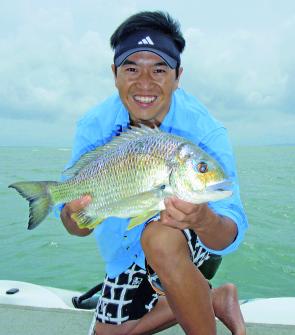After the passing of another hot, long summer it is a welcome relief to finally have some cooler days on the water. Conditions are slowly becoming more predictable as high pressure systems move up into central Australia.
Early mornings when the westerly winds are glassing conditions, it is prime time to be on the water as the fishing has been outstanding. There is no better place in the world than being on the water pre-dawn and watching the daybreak as your first fish hits the deck.
Bream have been running hot around all the inshore reefs and headlands with some absolute stonkers regularly being caught. These fish are currently in pre-spawn feeding as they begin to congregate around river mouths and headlands.
Hardbodies, like Jackall Chubbies and Atomic Hardz, have certainly taken their fair share of bream both deep around the drop-offs as well as super shallow in less than 1ft of water. Quality fish can also be taken on small surface presentations like Lucky Craft Sammie 65’s, Bevy Prop 55’s and Megabass Dog X JR’s during the top of the tide.
Making the most of tides and learning where the better fish hold at every given time is the key for anglers looking to tangle with these super lightweight heavyweights. As the tide is high bream tend to move up over reef flats and along the tops of bommies feeding on baitfish. Then they move out with the water into the deeper areas surrounding reefs where they forage mainly on crabs and molluscs. Timing either high or low water with key fishing times like sunrise and sunset will make for memorable fishing.
The last, and probably the most important influence for bream fishing are moon times (rise, set, overhead, and underfoot). The moon factor is often wrongfully overlooked by anglers aiming to chase kg+ bream. Getting two of the three peak times to coincide and you’re on the right track. For fishermen more inclined to use bait, try using unweighted single bait holder type hooks with small pieces of mullet or whole fresh hardiheads if you can get them. But beware of the hordes of smaller pickers and blowies. Establishing a good berley trail by scattering chicken pellets soaked in tuna oil will bring bream into range from afar when anchored.
Longtail tuna are beginning to show up in good schools around the usual areas from the southern tip of Bribie Island, Pearl Chanel, wide of Redcliffe Peninsular, Mud Island and the Paddock to the east (just beware of the new green zones). The better schools of tuna have been feeding rigorously on schools of small pilchards and have turned on some substantial surface boils. Fish of up to 30kg are common but most are in the range of 10-15kg, even the smaller longtails are a worthwhile adversary especially in the shallow waters of Moreton Bay.
Some anglers have recently been adapting the smaller bream and bass vibration blades like TT’s Switchblade to fish the surface schools rather than the standard high speed metal slices. The blades can be worked fast or at slower speeds and are much more enticing for spooked fish to strike. The slight shimmy action of a sinking blade falling through the water column also works well when probing for deeper tuna schools. Upgrading the hardware on blades is necessary as tuna jaws make short work of trebles and split rings. Changing to tropical strength trebles or even a single rear hook works best, split rings must be changed over to a heavy stainless steel type like SPROs super strong rings.
Only smaller snapper have been caught so far on the shallower bay reefs with the better fish reaching 50cm. Dark hours have produced the best results for anglers targeting the inshore reef, which is typical at this time of the year. Those targeting snapper on plastics have had a struggle in finding the schools and then they have hordes of little pinkies to contend with before hooking into decent fish, but persistence is key to producing a decent feed. Using heavier jigheads around 1/4oz is necessary in May and into winter, as the inshore currents are still quite strong. It also allows the plastic to remain in the strike zone longer when the smaller schools of snapper are located.
As winter progresses and the water begins to clear lightening jighead weight is a good idea, and gives the plastic more of a slow waft down through the water column. During May locating snapper holding in deeper water, like around the mouth of the Brissy River, will produce your best chances of tangling with some real horses, as well as the many other species that congregate in the deeper river channels at this time. My fingers are crossed for a better bay snapper season than last year.
Beacons are producing some good pelagic action for anglers using live baits. Small cobia are in good numbers and are beginning to gather in small schools towards the top and bottom of the tide. The use of a well established berley trail of tuna oil and pilchard cubes will have cobia feeding right up to the stern of your boat. Using a sounder to search beacons for bait schools will help to reduce waiting several hours before the fish come to you. Towards the end of May expect to see the smaller cobia give way to larger fish so using heavier tackle will be necessary to stop their initial sizzling run.
Have a great month on the water and enjoy the mild mornings, as May really is the best month of the year to be wetting a line in the Northern Bay.
Reads: 3045
Grayson Fong nailed this cracking 42cm fork length bream on a shallow Jackall Chubbie in less than 1ft of water.

There are plenty of surface munching bream about in May. This 36cm model nailed a Lucky Craft Bevy Prop 55 fished on 4lb line and a Blue Acres 7” Racks Elite Rod.




